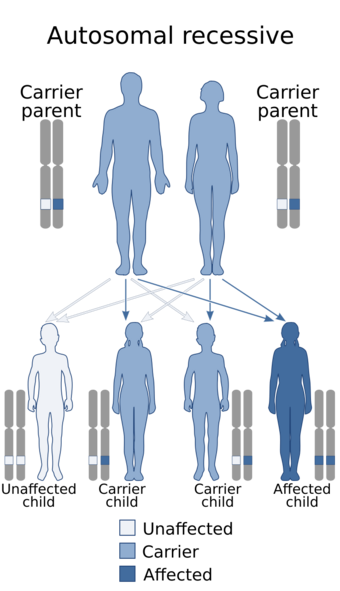Medicine:Hereditary pyropoikilocytosis
| Hereditary pyropoikilocytosis | |
|---|---|
| Other names | Pyropoikilocytosis hereditary [1] |
 | |
| Hereditary pyropoikilocytosis is autosomal recessive | |
| Specialty | Hematology |
Hereditary pyropoikilocytosis (HPP) is an autosomal recessive form of hemolytic anemia characterized by an abnormal sensitivity of red blood cells to heat and erythrocyte morphology similar to that seen in thermal burns or from prolonged exposure of a healthy patient's blood sample to high ambient temperatures. Patients with HPP tend to experience severe hemolysis and anemia in infancy that gradually improves, evolving toward typical elliptocytosis later in life. However, the hemolysis can lead to rapid sequestration and destruction of red cells. Splenectomy is curative when this occurs.
HPP has been associated with a defect of the erythrocyte membrane protein spectrin and with spectrin deficiency. It was characterized in 1975.[2] It is considered a severe form of hereditary elliptocytosis.[3]
Causes
Mutations of the alphaspectrin gene causes this disease.[4] HPP can be considered as a subset of hereditary elliptocytosis.[5]
Diagnosis
Genetic testing for the presence of mutations in protein molecules is considered to be a confirmatory testing technique. It is important to know the risks regarding the transmission and dangers of HPP.[6]
Treatment
Splenectomy is a possible treatment[citation needed]
See also
- Erythrocyte
- Poikilocytosis
- List of hematologic conditions
References
- ↑ "Pyropoikilocytosis hereditary | Genetic and Rare Diseases Information Center (GARD) – an NCATS Program". https://rarediseases.info.nih.gov/diseases/4619/index. Retrieved 17 July 2019.
- ↑ "A congenital haemolytic anaemia with thermal sensitivity of the erythrocyte membrane". Br J Haematol 29 (4): 537–43. 1975. doi:10.1111/j.1365-2141.1975.tb02740.x. PMID 1191563.
- ↑ "Detection of hereditary pyropoikilocytosis by the eosin-5-maleimide (EMA)-binding test is attributable to a marked reduction in EMA-reactive transmembrane proteins". International Journal of Laboratory Hematology 33 (2): 205–11. April 2011. doi:10.1111/j.1751-553X.2010.01270.x. PMID 21054813.
- ↑ "Pyropoikilocytosis, Hereditary disease: Malacards - Research Articles, Drugs, Genes, Clinical Trials". http://www.malacards.org/card/pyropoikilocytosis.
- ↑ "OMIM Entry - # 266140 - PYROPOIKILOCYTOSIS, HEREDITARY; HPP". http://www.omim.org/entry/266140. Retrieved 9 July 2018.
- ↑ "Final Diagnosis -- Case 623". http://path.upmc.edu/cases/case623/dx.html. Retrieved 9 July 2018.
External links
| Classification |
|---|
 |

